Apple 27-inch LED Cinema Display Review
by Anand Lal Shimpi on September 28, 2010 12:15 AM EST- Posted in
- Displays
- Mac
- Apple
- Cinema Display
Brightness and Contrast
For brightness, black level, and contrast points, we use the same colorimeter setup described earlier. Specifically, we use an Xrite i1D2 with ColorEyes Display Pro, and take measurements at maximum and minimum brightness of white and black targets. Dynamic contrast is turned off. We also let the panels settle in for a half hour at the respective settings before taking any measurements.
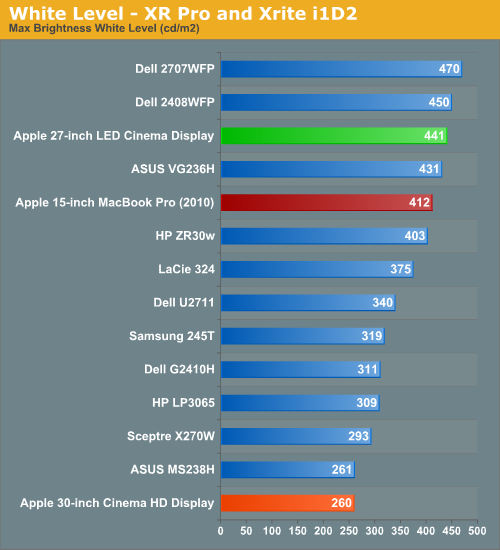
The new 27-inch LED Cinema Display is bright. It's within 10% of the 2707WFP and brighter than Dell's CCFL backlit U2711, which has a similar panel to what Apple uses in the 27-inch LED Cinema Display. If you're a fan of very bright displays, the 27-inch won't disappoint. I tossed in my 30-inch Cinema HD Display results as a reference point but keep in mind this is a very old unit (originally purchased in 2004) so it's not going to perform quite as good as it did while new.
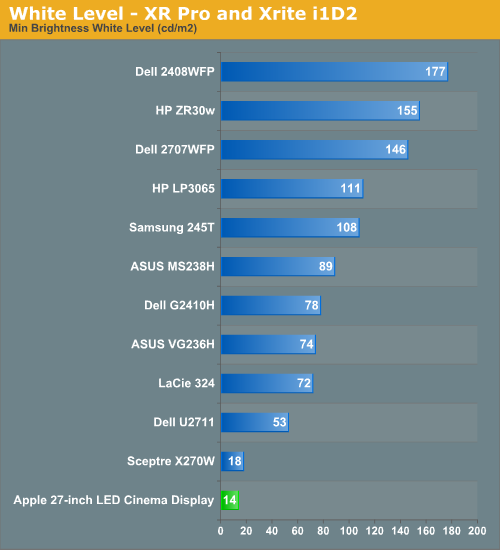
Drop brightness all the way and the 27-inch LED Cinema Display gets dim. There's a good amount of dynamic brightness range on this display, it's very flexible.
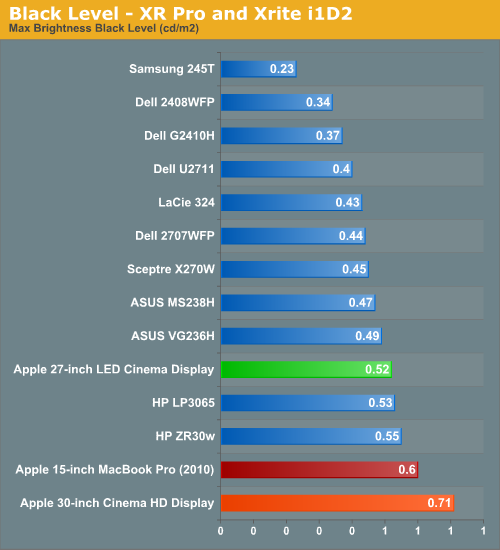
Absolute black levels are simply ok, not stellar for a high end display but not horrible either. It's clear Apple optimized for maximum brightness rather than deep blacks in order to compensate for the glossy front cover.
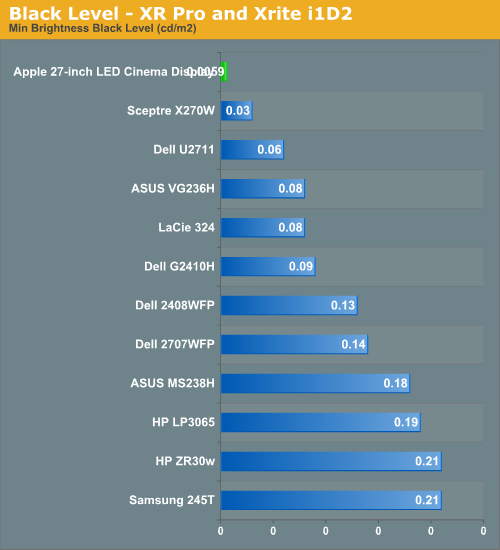
At the lowest measurable brightness setting the black levels are very low. You can actually get the display dark enough for my eyeOne D2 to register 0 nits. I had to bump brightness up a bit just to get the black level to register.
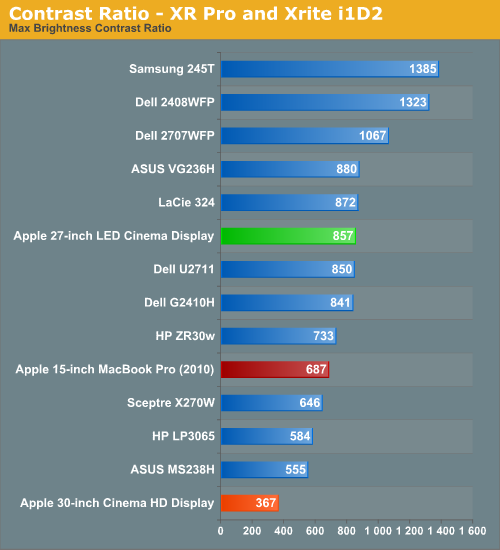
This isn't terrible but I would've liked to see something above 1000:1. Again it's sort of middle of the road for a high end display. Note that even at 200 nits the contrast ratio is 837:1, so unless you significantly reduce brightness you won't see a huge difference in contrast ratio.
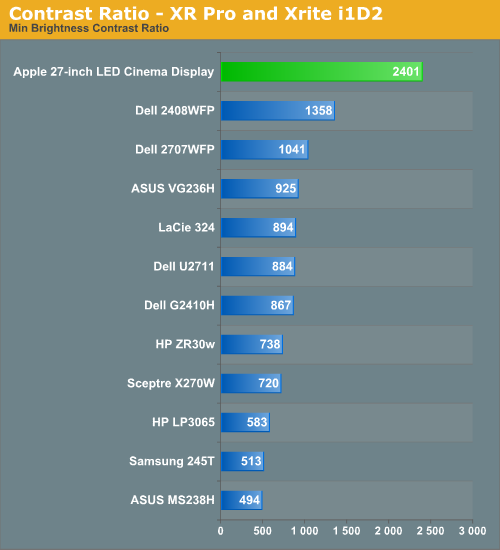
Thanks to very low black levels at the lowest brightness settings the contrast ratio skyrockets. As I mentioned before, at 200 nits the contrast ratio is still down at 837:1 so the numbers above aren't very real world unless you like using very dim displays. You can also count on the 27-inch display being quite usable at lower brightness settings as a result.










93 Comments
View All Comments
ijhammo - Tuesday, September 28, 2010 - link
nicely put Targongeok1ng - Tuesday, September 28, 2010 - link
At $999 this display is a bit overpriced.The low-end 27" iMac starts at $1699, featuring core i3 530, 4GB DDR3, Slim DVD, 1TB HDD, Radeon 5670 mounted on a notebook LGA1156 mobo.
This hardware costs more than $470 on newegg, and the miniDP on the iMac can receive external video sources ( not to mention a possible hack to directly mount the iMac display externally).
It would solve the main problem showed on the review: the self fulfilling prophecy that this display will only be used with Macs.
The ideal Imac for hacking is the $1999 i5 + Radeon 5750. For another $1000 you get the very same display coupled with a valid mid range hardware all-in-one.
Cattykit - Tuesday, September 28, 2010 - link
Nice assumption but I doubt if it really is the case.What I recall is that when this S.Korean company introduced one of their IPS monitors in U.S a few years ago, they increased price about $300 (compared to S.Korean price) and people went crazy for it as it was considered very cheap compared to what was availbe in the market.
Being interested in that, I did a breif research on IPS monitor market in S. Korea. What I found out is that a. there are so many feature packed IPS monitors b. they are much cheaper.
Of course, LG - the IPS pannel maker - is a S. Korean coporation and that should explain the difference in market situation. However, what's interesting is that all other products that came from S. Korea - Samsung, LG, and even Hyundai automobiles- are cheaper in U.S than in S. Korea.
After all, I couldn't figure out why IPS monitors are so much more expensive in U.S, not to mention lacking availability.
P.S: After writing this, I did a simple search of IPS monitors on S. Korean electronics site. Keep it mind below are only a very small representation of hundereds of monitors in the S. Korean market. Last time when I did throughout research, it took me days and days.
27" 2560 x 1440 IPS for $420 (sales tax included),
26" 1920 x 1200 IPS for $500 (built-in HDTV tuner, speaker, PIP, D-SUB, HDMI, Component, DVI, RF Antenna, Tilt Swivel)
30" 2560x1600 IPS for $620.
numberoneoppa - Tuesday, September 28, 2010 - link
Because this is a high-density IPS panel. It's really not too outrageous a price.andy o - Tuesday, September 28, 2010 - link
I'm more annoyed that they are going for 16:9 in even the highest-resolution computer displays. There is no reason for it, you're only losing desktop space.xype - Tuesday, September 28, 2010 - link
Seeing how most applications have their palettes and settings in a column (either to the left or to the right of the main working space), I don't see how a wide ratio is a problem? Also, the ratio has nothing to do with the amount of pixels you can show—if you want higher pixel count, you want higher pixel count. If you want a ratio that's more of a square, you want that. If you just want a taller screen at the same width, go with one of the 30" ones.LordanSS - Tuesday, September 28, 2010 - link
I'll base my response on the fact that I am a computer gamer.For that kind of stuff, perhaps a LCD like this might be overkill... and considering the very slow response time of 12ms, might not be good at all, as you can find many TN panels around with a quarter or less response time (GTG) compared to that.
Anyways, the vertical loss of pixels is an issue for several games, specially ones with customizable UIs, where you can move around windows and whatnot. MMOs come to mind. Those missing pixels, in this case, do make a big difference in your viewing area.
vol7ron - Tuesday, September 28, 2010 - link
Customizable UIs generally have the ability to put menus on the side, but true "gamers" would rely on a better keyboard than the onscreen interface.As xype has said, it's pixel count that you want. 27w" is the diagonal width, which would have the same vertical pixels as a 20-21" monitor at 4:3.
BTW, if height is what you're after, you can rotate your monitor to 9:16 instead, it's only a matter of switching a setting in video preferences, but wider field of view is actually more important for gaming, especially in FPS, but also in MMORPGs.
Strunf - Thursday, September 30, 2010 - link
"but wider field of view is actually more important for gaming, especially in FPS"That is if you play "flat" FPS where everyone is at the same level, if you play FPS where players can be on top of buildings and what not the height becomes a very important factor, 16:10 is for me the best ratio available... also a 16:9 doesn't necessarily have a wider field of view than a 4:3, both could have the same horizontal resolution while the 4:3 would have a higher vertical one.
I really don't get how the 16:9 is becoming the norm when its not a progress for gamers on the contrary...
crimson117 - Tuesday, September 28, 2010 - link
MS Word 2007 has the menu at the top of the screen, not to the side.